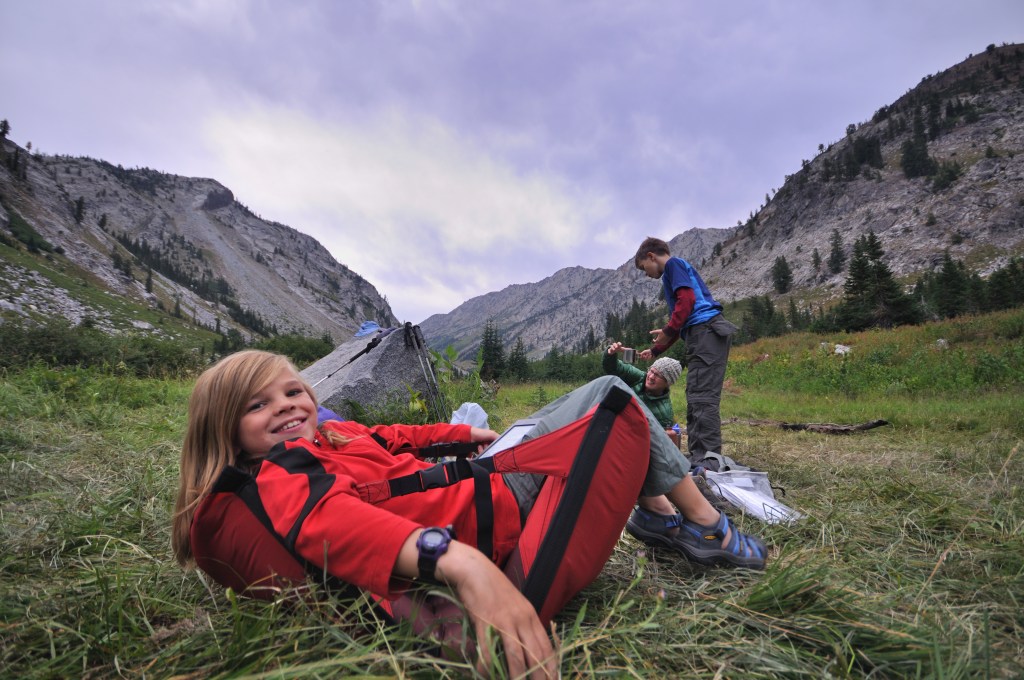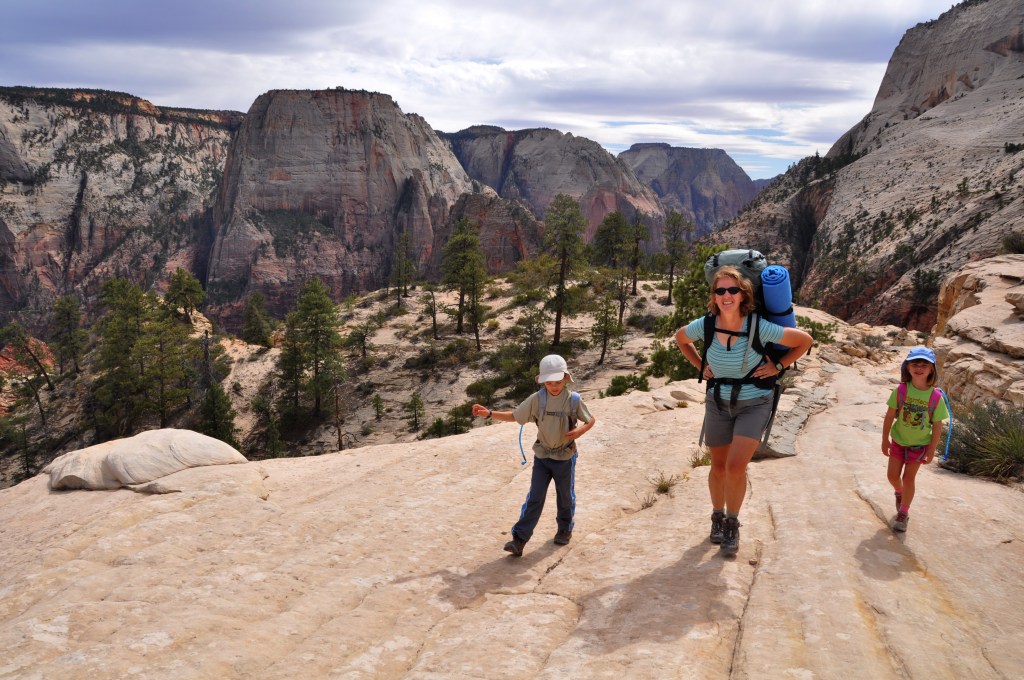As we hiked uphill toward Gunsight Pass in Glacier National Park, on a three-day family backpacking trip, a couple in their 50s stopped to talk with us. They smiled at our 9-year-old son, Nate, and 7-year-old daughter, Alex, and said, “We’re impressed! We never had any luck trying to get our kids to backpack when they were young.” After a bit more chatting, we headed off in opposite directions.
Then Alex turned to me with a very serious expression and said, “You didn’t get us to do this. We wanted to do it.”
Her words, of course, warmed my heart. But her comment also spotlighted the biggest lesson for parents hoping to turn their kids into eager backpackers: Create experiences that make them want to go out again.
General Tips
As a parent who wants to get kids out on the trails, two of my most important hard-earned lessons are to “tear up your agenda” and “talk and listen.” Young children thrive on their parents’ attention—and believe it or not, even your teenagers want your approval, no matter how much they seem to want nothing to do with you. Give them your attention and approval in an outdoors setting, and they’ll associate the outdoors with that reward.
Here are some other hard-earned tips on backpacking with kids:
- How far should you hike? Whatever their ages, start easy and make incremental increases in difficulty—you don’t want kids to think it’s hard, at least until they’ve learned they sometimes have to endure difficult moments for the larger rewards. The first time, just hike a few miles (or less) to a lake and make camp, and use it as a base for short day hikes, fishing and afternoon swims. Have a quick bailout to the car in case of a sick child, terrible weather or gear failure.
- Get lightweight gear. Backpacking with young kids means parents carry just about everything, and lighter gear can make the difference between you hauling under 50 pounds versus over 60 pounds. That’s money well spent.
- It’s always all about food. Many times I’ve been reminded: A grumpy child is often just a hungry child. An energy bar or other snack will usually shift a tired, complaining kid’s mood 180 degrees, whether they’re 4 years old or 14. Or just stop and have lunch.
“If you want to go hiking as a family, don’t ask your child, ‘Do you want to go hiking?’ Just say, ‘We’re going hiking.’ Trust me on this. You’re in charge, and if you’re serious about wanting a family that hikes and spends a lot of time outdoors, be the captain.”
—Shelli Johnson, adventure guide, yourepiclife.com

Alex, at age 9, hanging out at camp in the Eagle Cap Wilderness, OR. (Photo Credit: Michael Lanza)
Age-Specific Tips
Kids grow fast and backpacking trips with them evolve as quickly as their abilities. Follow these tips to achieve the desired end result: that everyone’s happy. Modify this backpacking gear checklist to suit each trip.
Ages 3 and Under
- Up to around age 3, a child can be carried in a front or back child-carrier pack and cover more ground than when that kid is walking—and sometimes that’s necessary. But don’t get too goal-oriented. You want to teach your child that she or he is a hiker, not just along for the ride. And it’s more fun for a child to explore nature rather than be carted through it.
- Forget a sleeping bag for little children—a squirming, sleeping tyke will slip out of it several times a night. Dress your babies or toddlers in a fleece bunting or light long underwear, and cover them with their favorite blanket. Use a short foam pad like a Therm-a-Rest Z Lite Sol or the REI Co-op Kindercamp Sleeping Pad for insulation.
- Small kids run out of gas quickly. Stop frequently for drinks, snacks and short rests.
- In cool or cold temperatures, periodically check a baby’s or toddler’s hands and feet. If they feel warm, their body’s warm, too, indicating your child is fine. If hands or feet feel cold, check spots like neck and chest to determine whether he or she needs more clothing or just better mittens or boots—or if it’s time to cut the hike short.
Bring: an ultralight tent. Little kids need little sleeping space, and you definitely need a lighter pack. When our kids were little, we spent a lot of nights in the Big Agnes Copper Spur UL 4, which had adequate living space for us; its successor, the Copper Spur HV UL 4, is even lighter at just over 5 pounds.
“Figure out how many diapers to bring and how to pack them out. Ask a toddler every 15 minutes if he has to pee, especially before putting him in the child-carrier pack.”
—Melissa Avery, chasquimom.com
Ages 4 and 5
During these years when a child is too big to carry and too small to walk very far, day hiking and car camping work fine for many families. But backpacking isn’t impossible, and hiking with a child at this age, as memories are forming, makes it a “normal” family activity in her or his eyes.
- Plan short backpacking trips that take in lakes warm enough for swimming and streams safe to play in.
- Invent word games to occupy kids while hiking. My family played “The Story Game” for years: We would make up a fictional story (it usually involved protagonists that resembled our kids), taking turns adding to the spoken narrative, with the plot growing increasingly crazy.
- Give a young child simple responsibilities, like helping to pitch the tent, to encourage her or his sense of self-confidence.
Bring: favorite stuffed animal, an e-reader for tent time and patience—plus a first piece of gear for a child, to make her feel “big.” Little kids love headlamps, like the Princeton Tec Bot for kids.
“We invented a system called ‘Trail Fairy.’ I’d be in in the front, and [my husband] would be in back, and … if one of the boys was complaining or falling back … one of us would fling a baggy into the air that would magically fall from the sky. … Inside the baggy was a treat with a note from the Trail Fairy complimenting him on his amazing hiking abilities. This trick worked every time.”
—Shelli Johnson, adventure guide, yourepiclife.com

Michael Lanza’s family travels on the West Rim Trail in Zion National Park. Nate (left) at age 9, wife Penny Beach, and Alex (right) at age 6. (Photo Credit: Michael Lanza)
Ages 6 to 10
Children make significant advances in physical ability every year. Sometime between ages 6 and 8 many kids are ready for “real” backpacking trips, hiking up to several miles a day in the mountains.
At this age, a child can begin carrying a child-size backpack—but keep it light (sleeping bag and pad, water, snacks, personal clothing and small items), and don’t force the issue. I let my kids ask for their own backpack: They perceived it as something adults and big kids do, rather than something they were told to do. Give them a 1.5-liter reservoir (barely more than 2 pounds full), and they can drink more easily than digging out a bottle.
Children this age need constant reminders to drink water, and they burn through their energy reserves fast. Bring more food that they like and will eat than you think you need. They need the calories, and special treats can help make it a memorable experience for them. Don’t worry, they’re burning it off, and there’s no such thing as having too much energy when hiking.
Start teaching them hiking, camping and safety skills now. They’re quick learners and respond eagerly to new, big-kid responsibilities, like lighting the stove, reading the map, pitching the tent, and when they’re ready, building a campfire.
Bring: swim suits, ingredients for s’mores, binoculars for viewing wildlife, a child’s own Swiss Army knife.
“Include your kids in the planning phase of the trip—let them read maps, load backpacks, choose snacks, etc. They feel more invested in it rather than being dragged along.”
—Stacey Wilcox, anoutdoorsfamily.com
“My 9- and 6-year-old kids like to be hiking in front, being the leader and setting the pace. It gives them a sense of empowerment to watch for trail signs and crossings, and allows them to set a pace that is manageable for them—they won’t worry about getting left behind.”
—Kristina Bourne, outsideinduluth.com

Nate, at age 11, and Alex, at age 9, hiking to Hawkins Pass in the Eagle Cap Wilderness, OR. (Photo Credit: Michael Lanza)
Ages 11 to 13
Your kids have reached an age where they can do almost anything adults can do—sometimes more. They’ll want an adventure, so deliver it. Even if it means challenging your own comfort zone or learning new skills (or hiring a guide or taking a guided tour), consider climbing a mountain, exploring a slot canyon or hiking hut-to-hut.
Give kids this age more freedom, for instance, to explore on their own or share a tent with friends.
Bring: a waterproof camera/phone or a GoPro. Install a fun phone app like Skyview (it’s free), which identifies constellations and other celestial bodies. Double-check your child’s pack to make sure she or he has everything. (My son, then 11, once forgot a rain jacket, insulation layer and warm hat for a five-day backpacking trip. Guess whose he wore?)
“Plan leisurely morning starts—waking up early is a mood killer for teens.”
—Laure Latham, frogmom.com

Nate, at age 15, backpacking above Baron Lakes, Sawtooth Mountains, ID. (Photo Credit: Michael Lanza)
Before becoming a dad, my main concern was the age at which my kids would “catch up” to my abilities. I had no idea how much I’d enjoy spending time outdoors with them. Now, I realize the single greatest value of our family time on backpacking and other trips has been that we have only one another and nature for entertainment—no electronic devices that erect virtual walls between us. On our family wilderness trips, we spend hours a day just talking, listening and laughing.
As my young daughter said so many years ago, we didn’t “get” our kids to do those things with us. They want to do them—and our lives are better for that.
